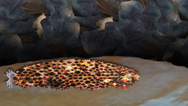Kangaroo Gas and Global Warming
- By Anna Rothschild
- Posted 04.23.15
- NOVA
Cows burps release a ton of methane into the atmosphere. Can other animals, like kangaroos, teach us how to make cow gas more eco-friendly? Find out in this episode of Gross Science.
Transcript
Kangaroo Gas and Global Warming
Posted: April 23, 2015
Anna Rothschild: Could kangaroo farts help us curb global warming?
I’m Anna Rothschild, and this is Gross Science.
So, in order to understand how kangaroo farts have anything to do with global warming, let’s first just back up and talk about what a greenhouse gas is. And I promise, this will take under 20 seconds.
Greenhouse gases are gases in our atmosphere that trap heat. In moderation, they’re actually vital to life on Earth, since they keep our planet from being a cold, barren wasteland. But, when we pump the atmosphere full of them, they trap tons of heat and make the planet warmer.
A greenhouse gas we talk a lot about is carbon dioxide, since that’s what comes out of cars and many factories. But another important one is methane, which comes from lots of places, include cows.
Cow burps, along with their farts and manure, release a ton of methane. In fact, livestock are one of the major producers of methane worldwide, and cows are the worst offenders.
You might think that the cows produce so much methane because of what they eat. But interestingly, kangaroos, which have a very similar, plant-based diet, actually release way less methane. Scientists looked into why this was happening, and they discovered that both cows and kangaroos have microbes in their guts that aid in their digestion. But cows primarily use microbes that create methane as a by-product, while kangaroos use ones that produce something called acetate, which is not a greenhouse gas.
So, to help curb global warming, researchers are hoping to make cow guts more like kangaroo guts. Recently, they found that both cows and kangaroos share one particular acetate-producing microbe. One day, perhaps they’ll be able to ramp up the activity of that microbe in cows, so cows will also produce more acetate than methane.
Now, just for a little reality check, how worried should we really be about burping and farting cows? Well, humans produce more greenhouse gases in total from things like industry and transportation. However, methane is excellent at trapping heat—it’s actually 21 times better at it than carbon dioxide—which means that cow gas is really nothing to laugh at.
Ew.
Credits
PRODUCTION CREDITS:
- Host, Writer, Animator, Editor
- Anna Rothschild
- DP, Sound, Researcher, Intern Extraordinaire
- Elizabeth Gillis
- Many thanks to Dr. Scott Godwin.
- Anode (c)
- Music Provided by APM
IMAGES
- Factory Smoke Blankets Clark Avenue-Nara-550191
- Wikimedia Commons/NARA
- Humo negro
- Wikimedia Commons/Ivan2010
SFX
(used with permission from author)
IMAGE
- (main image: Kangaroo Island kangaroo Macropus fuliginosus fuliginosus)
- Flickr/Paul Asman and Jill Lenoble
Sources
Want more info?
Godwin S., Kang, A., Guilino, L., Manefield, M., Gutierrez-Zamora, M., Kienzle, M., Ouwerkerk, D., Dawson, K., Klieve, A. (2014) Investigation of the microbial metabolism of carbon dioxide and hydrogen in the kangaroo foregut by stable isotope probing. The ISME Journal, 8, 1855-1865.
http://www.nature.com/ismej/journal/v8/n9/abs/ismej201425a.html
Overview of greenhouse gases, sources of emissions, and tons of data from the EPA:
http://www.epa.gov/climatechange/ghgemissions/
Gizmodo on how much cow gas actually contributes to global warming:
http://gizmodo.com/do-cow-farts-actually-contribute-to-global-warming-1562144730
Related Links
-

The Poop Cure
Fecal transplants are surprisingly effective cures for a dangerous bacterial infection.
-

Sea Cucumber Evisceration
Sea cucumbers can expel their internal organs and then regrow them.
-

The Three-Foot-Long Footworm
Guinea worms have plagued humans for millennia, but they’re almost extinct.
-

What Does Disease Smell Like?
Sometimes doctors can diagnose you based on how you smell.

